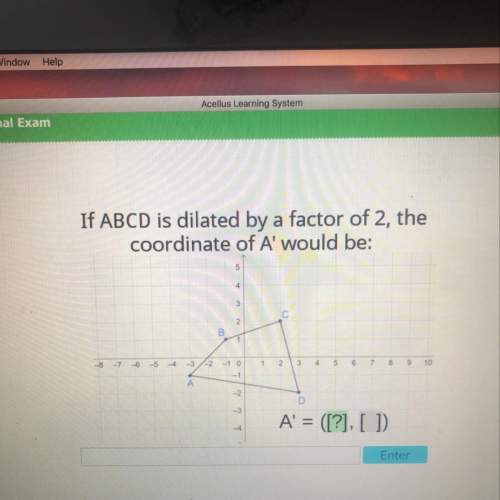
Mathematics, 27.07.2020 19:01 ghetauto
Max is trying to prove to his friend that two reflections, one across the x-axis and another across the y-axis, will not result in a reflection across the line y = x for a pre-image in quadrant II. His friend Josiah is trying to prove that a reflection across the x-axis followed by a reflection across the y-axis will result in a reflection across the line y = x for a pre-image in quadrant II. Which student is correct, and which statements below will help him prove his conjecture? Check all that apply.
Max is correct.
Josiah is correct.
If one reflects a figure across the x-axis from quadrant II, the image will end up in quadrant III.
If one reflects a figure across the y-axis from quadrant III, the image will end up in quadrant IV.
A figure that is reflected from quadrant II to quadrant IV will be reflected across the line y = x.
If one reflects a figure across the x-axis, the points of the image can be found using the pattern (x, y) Right-arrow (x, –y).
If one reflects a figure across the y-axis, the points of the image can be found using the pattern (x, y) Right-arrow (–x, y).
Taking the result from the first reflection (x, –y) and applying the second mapping rule will result in (–x, –y), not (y, x), which reflecting across the line y = x should give.

Answers: 2
Another question on Mathematics

Mathematics, 21.06.2019 21:00
The zoo collects $9.60 for every 24 tickets sold. how much will be collected for 400 tickets?
Answers: 2

Mathematics, 21.06.2019 23:00
The price of a car has been reduced from $19,000 to $11,590. what is the percentage decrease of the price of the car?
Answers: 1

Mathematics, 22.06.2019 02:30
Aresearch study is studying the effects of a new drug for osteoporosis alzheimer's disease (ad) for women above the age of 65 years. a group of individuals with osteoporosis is randomized into two groups. one group is treated conventionally, and the second group is treated with the new medication. assessments are made at 3, 6, 12, 36, and 48 months. the conventionally treated group is assessed for ad using a serum blood test, and the treatment group is assessed for ad using a pet radiotracer that binds to beta-amyloid plaques. in comparing these 2 trial arms, the authors of the study may encounter which type of bias? a. selection bias on the risk of developing b. measurement bias c. confounding bias d. recall bias e. lead-time bias
Answers: 2

Mathematics, 22.06.2019 02:30
The focus of a parabola is (-4,-5) and its directrix is y=-1 find the equation
Answers: 3
You know the right answer?
Max is trying to prove to his friend that two reflections, one across the x-axis and another across...
Questions


Computers and Technology, 25.12.2019 07:31

Mathematics, 25.12.2019 07:31


Mathematics, 25.12.2019 07:31

Mathematics, 25.12.2019 07:31


History, 25.12.2019 07:31


History, 25.12.2019 07:31



Mathematics, 25.12.2019 07:31

Social Studies, 25.12.2019 07:31

Mathematics, 25.12.2019 07:31



Chemistry, 25.12.2019 07:31

Social Studies, 25.12.2019 07:31




